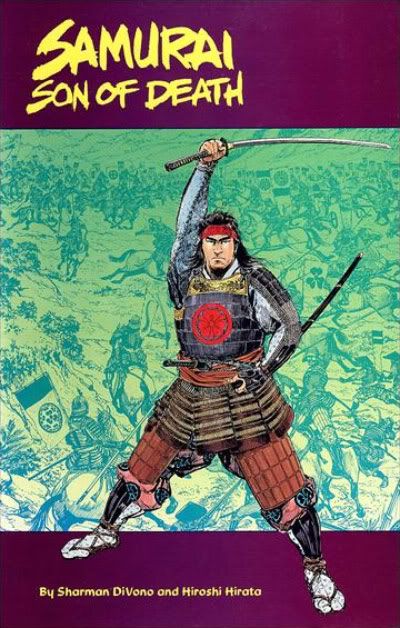
Writer: Sharman DiVono, Art: Hiroshi Hirata.
Eclipse Comics, 1987.
(This review originally appeared at Weird Crime Theater.)
Because of my own personal experience, I tend to approach fiction about Japan by Westerners with a spoonful of suspicion. Typically I find even pro-Japan works to be either somewhat or grossly based on generalization born of not spending long enough in the country, or not trying hard enough to get to know the people. Though, naturally, my own opinions of Japan are based on my own generalizations as well.
Samurai, Son of Death plays it mostly on the safe, historical (though partially fictionalized) side of things, detailing a few military campaigns in the days of feudal Japan and never delving too much into the personalities of the players except what could be summarized in a few sentences in a textbook.
This works both for and against it. The opening character “recap” page is so complex, it makes you feel like you’re jumping in on the 256th issue of X-Men. But it’s actually mostly just background historical detail. Confusing things, one of the characters listed has the wrong portrait associated with his description. And the description of Harada Sadayasu who “undergoes a bizarre supernatural metamorphosis” is confusing, because it makes it seem like it happened beforehand, but we see it happen in the pages of the book.
That metamorphosis — in which Harada is seemingly resurrected from death on the battlefield about halfway through the 45-page book — is where the story starts to get a bit more interesting. As I’ve mentioned in other reviews elsewhere, I have no patience for details of military action or tactics or strategies or even subterfuge. But Harada’s resurrection brings certain philosophical elements — especially as it affects the minority Christian characters — into play that had me thoughtfully stroking my goatee a little bit. Having re-read the first six issues of Frontline Combat some time back, I found especially tedious all this talk about war with nobody ever asking why except for a throwaway line by a peasant in the middle of the book. A quotation on the first page suggests that, for the samurai caste, war was their religion, but even if that was true for the participants, some interrogation from the author would have been nice, rather than simple fetishization of facts. I also didn’t like the approach to the dialog, which at times seemed to be deliberately stiff, as if to mimic the effect of a work in translation
All that said, the hyper-detailed, hyper-textured, realistic art by famed period-manga artist Hiroshi Hirata is spectacular. Samurai, Son of Death is billed as “the first comics collaboration between an American writer and a Japanese artist.” It’s telling that this first artist to collaborate has adopted both a rendering style and approach to layout which is dramatically dissimilar to what we might traditionally think of as a “manga style.” But it’s hard to imagine a Western artist of the era doing work this (I’m assuming) accurate on the project. And if anything it reminded me strongly of Jack “Jaxon” Jackson — appropriate considering the historical subject matter.
Hiroshi Hirata’s work is also particularly famous in Japan for his brush lettering (he created the logo for AKIRA) — something missing for obvious reasons in the OEL Samurai, Son of Death. However, it is preserved to some extent in the Dark Horse editions of his series Satsuma Gishiden. And based on the weakness of the “story” here as well, I would recommend checking out Satsuma Gishiden instead.

KS
————————————————————————————-
Kumar Sivasubramanian is the writer of Weird Crime Theater.
